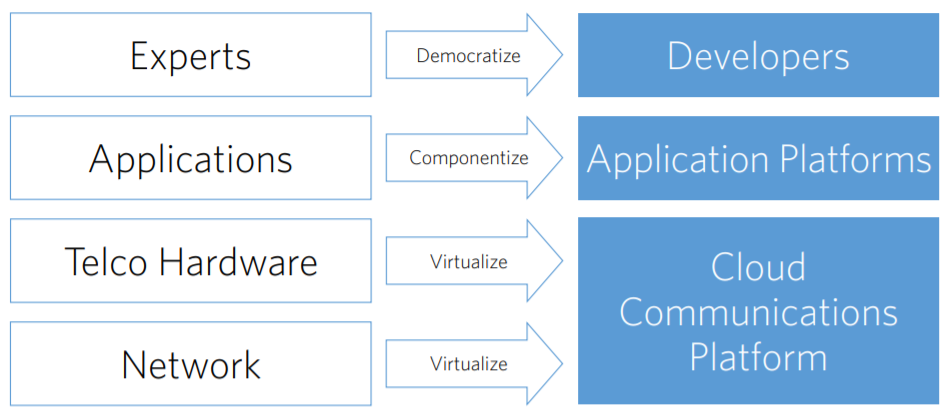[TWLO] Twilio
From its origins as on-premise installations sold to CTOs, enterprise software has expanded to include to SaaS applications sold to business users and now to Application Programming Interfaces (APIs) sold to developers. As I explained in my Okta post:
Twenty years ago, it probably wouldn’t have made sense to fashion a whole company around, say, a payments function whose primary interface was an API. You would not have found enough customers for it. E-commerce was a budding opportunity with uncertain prospects. But as the internet matured, online commerce got big enough to justify the creation of companies whose sole purpose was selling the constituent pieces of what were hitherto fully integrated solutions….Rather than devote scare developer resources to building generic but important features, an enterprise can simply consume best-of-breed third-party versions. Stripe, SendGrid, Twilio and Okta offer functions whose use cases are common and generic enough (payments, email, messaging, and identity/authentication, respectively) that they can be built once – by a company whose only job is optimizing that function – and embedded across countless applications
APIs handle generic background infrastructure type things so that developers can focus their efforts on creating unique business value. Twilio puts a blanket of software on top of telco infrastructure so that developers building communications into their app need not concern themselves with all the boxes and cables on the left (below).
The communications stack has historically been comprised of telco hardware from Avaya and Cisco plugged into networks built and operated by Verizon, BT and other carriers. More geographic coverage meant more boxes in more locations. The software monoliths embedded in those boxes were installed and customized on-premise by third-party system integrators, often months long affairs costing millions. Something as seemingly straightforward as building an Interactive Voice Response (IVR)1 would have required that an organization sign a deal with Verizon or AT&T, purchase equipment with IVR software from Avaya, train a natural language model in Nuance and hire a system integrator to bring everything together2.
With Twilio, all the complexity of a communications network is abstracted away by a few lines of code. Hardware is moved to the cloud and virtualized. Developers can just embed Twilio’s voice and natural language understanding APIs into their apps; business users can build IVR workflow logic by dragging and dropping visual representations of APIs in Twilio Studio.
Twilio’s APIs allow Lyft riders to communicate with drivers via text and voice; Pinterest and Box users to log-in with 2-factor authentication; Alaska Airlines to text flight updates to passengers. They power the communications function of a mobile app through which Morgan Stanley’s wealth managers text clients in a super compliant way. Just as Stripe’s APIs are used by Shopify to provide banking services for merchants, Twilio’s can be white-labeled by software partners to power voice, text, video and chat communications. Salesforce.com embeds Twilio in its Sales Cloud so that reps can call their customers from the app with one click. Redfin puts a distinct Twilio phone number on every listing page so that the agent knows exactly which house you’re calling about. ServiceNow uses Twilio’s SMS and Voice API primitives to send incident alerts.
Underpinning these capabilities is Twilio’s Super Network. Super Network is software that interconnects 1,500 of telecom carriers throughout the world, routing voice calls and SMS messages in the most efficient way possible. It procures phone numbers in 100 countries for different use cases so that, say, a San Francisco-based business can send messages from a 415 area code or a Lyft driver and a rider can communicate without either party revealing their personal phone number3. If a telecom carrier suffers an outage, which happens frequently, Super Network re-routes messages to ensure the end user experiences no downtime. Twilio monitors more than a billion data points/day to assess the health of its network and has supposedly gotten so good at this that it can identify problems even before its carrier partners do. As Twilio connects to more carrier nodes, it gets better at dynamically routing messages and expands its database of phone numbers, which draws more message volumes and yields more data to further optimize its network.
The idea of using software to hide underlying complexity also applies to communications platforms like Facebook Messenger, Alexa and WhatsApp, where Twilio stays current on API changes so that developers don’t have too. In essence, Twilio positions itself as the single choke point for developers to reach users across a whole bunch of channels. This is useful not only because different customers prefer to engage through different channels, but also because some communication mediums are more appropriate than others for a particular use case (for instance, someone shopping for a home in Zillow may want to receive new property alerts through SMS and a more comprehensive report of the property through email.)
Notwithstanding its growing portfolio of communications primitives, Twilio was still missing a critical one: e-mail. As Twilio increasingly pushed a bundled package of software and APIs into higher level strategic engagements, enterprise customers wanted email in the mix. You can’t be a choke point for all communications and not have email. So in 2018, the company converted its years-long partnership with SendGrid into a massive $2.7bn all-stock acquisition4. SendGrid offers an API used by developers and marketers to email users social media updates, reservations, receipts, account notifications, etc. When you re-set your passwords on scuttleblurb, the log-in link is emailed to you via SendGrid. SendGrid was like Twilio’s email twin: just as Twilio built a software layer connecting telcos, SendGrid did the same with ISPs. Just as Twilio migrated up the stack from voice and text APIs to more value-added software, so too did SendGrid expand from email API to marketing applications. Both companies embraced the same self-service developer-first approach.




